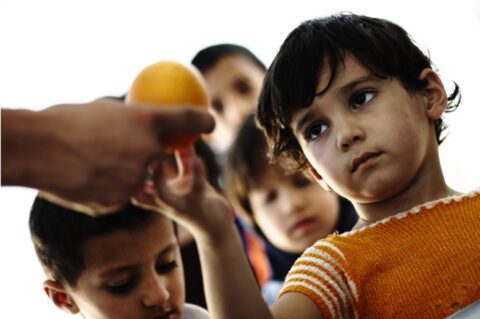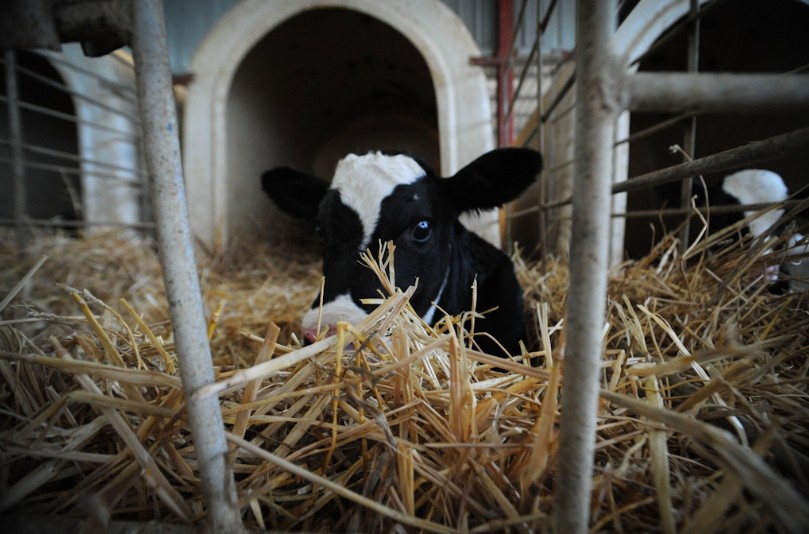News
New York Bill Aims to Ban New Mega-Dairies
Law & Justice•6 min read
Explainer
The facts don't lie: we’re using grain and other perfectly human-edible nutritious plants to bulk up animals for destruction instead of feeding people who can’t feed themselves.


Words by Sentient Media
Food insecurity refers to the uncertain availability of food and beverages. In fact, in some parts of Africa and Asia, women and children walk an average of nearly four miles for drinking water that isn’t always even safe to drink. And in the United States alone, one in six children goes hungry. We don’t think of healthy, nutritious food as a privilege, but millions of people do. They don’t have the money to buy food, they don’t have easy access to it, or they live in a part of the world where food sources prove contaminated.
It’s not just about hunger, either. Malnutrition can cause debilitating symptoms among those affected, from the inability to get warm and difficulty breathing to delayed wound healing and the loss of skin and hair health.
Complete starvation results in death within 8 to 12 weeks.
Every year, starvation claims 9 million lives. While 98 percent of people who suffer from food insecurity live in developing nations, a startling number of people in the developed world go to bed hungry every night.
According to FeedingAmerica, food insecurity impacts around 40 million Americans and 12 million American children. African Americans and Latinos are among the most affected populations, though anyone who lives without access to healthy food is considered to be in peril.
People with the lowest food security face disruptions in their access to food constantly or during specific seasons. The household must reduce or ration food to ensure its members’ continued survival.
Those who suffer from food insecurity often face poverty, homelessness, lack of medical care, and other serious issues in their lives. Most do not have jobs — or are so underemployed that they can’t meet their families’ needs.
Certain portions of the population are more impacted by food insecurity than others, whether because of their ages or because of where they were born. Worldwide, the following groups face less food security than anyone else.
There’s a simple reason children face more food insecurity than others: They’re unable to fend for themselves. Until they reach their late ‘teens, they cannot work, and they’re dependent on their older family members for survival.
Women who give birth to children in circumstances involving food insecurity sometimes don’t produce sufficient breast milk to nourish their babies. This results in low immunity to disease as well as malnutrition for both mother and child.
As children grow up, they might have to fend for themselves to find food — much of which might be contaminated by germs — and rationing food in households might be the norm.
Undernourished or malnourished children often face consequences that don’t impact adults as much. Developmental and growth delays, poor bone mineralization, and delayed organ development might plague these children if they’re too deprived of food.
However, since it’s parents’ instincts to care for their children before themselves, many families in areas rife with food insecurity will go hungry themselves so their children can eat. A vicious cycle begins — one that should never start in the first place.
Older adults also face more food insecurity than their younger counterparts. As people get older, their nutritional needs change. They need more calcium and vitamin D, for instance, because their bones become more brittle.
Additionally, the body gets weaker as it ages, so the elderly need more calories to maintain a healthy weight and to sustain their energy levels. When deprived of food, the elderly often succumb to serious illness or death much quicker than they would than if they were younger.
Food insecurity in the elderly can happen in both developing and developed countries. Older adults who don’t have retirement accounts or social security checks to keep them afloat as they age can slide into poverty, which means less access to food.
In developing countries, people often don’t reach old age. If they do, they don’t always have family members or communities to help them get the food and water they need to survive.
The farther away a person lives from a major city or town, the less access to food he or she enjoys. Transportation is a major factor in food insecurity. If a person or family lacks transportation, obtaining food from places even a few miles away can become impossible. Even if they can travel to more populated areas on foot, there’s only so much they can carry.
Rural poverty continues to deprive human beings of much-needed food all over the world. What one person might view as a relaxing oasis with all desired creature comforts, another knows that it’s another obstacle to obtaining nutritious food and clean drinking water.
Weather also impacts people in rural communities. In areas of extreme heat and cold, families must protect themselves from the elements regardless of whether or not they have something to eat. When a person becomes malnourished, their ability to tolerate extreme heat or cold erodes, as well.
Developing countries in Africa and Asia face enormous amounts of food insecurity. The least food-secure countries include The Central African Republic, Chad, Yemen, and Madagascar. In many of these countries, political instability is a major contributor to hunger among residents.
Despite the fact that Latin America offers some of the richest agricultural resources in the world, its people still face tremendous food insecurity. This is especially true among women, children, and people who live in rural areas.
Food travels across the oceans every day, and the United States is the largest exporter of food. Somehow, though, people still go hungry.
Despite the large quantities of food exported between countries, food prices can still make nutrition unattainable for people who live in poverty. Additionally, many countries halt food trades during periods of economic unrest, natural disaster, or poor harvests.
The problem isn’t that there’s not enough good. It’s that we aren’t able to provide food to the people who need it most.
South Sudan and Somalia are considered two of the most dangerous countries in the world. Socio-political unrest and other issues make simply living in or visiting one of these countries a dangerous pursuit. It’s no surprise, then, that these countries are also among the most food insecure.
When people are afraid to travel to a country, or when political issues become divisive, much-needed food doesn’t enter that country’s borders. The citizens suffer because of it.
One of the worst travesties is that the people involved in creating food for others often live with the most food insecurity. They can grow crops, for instance, but they must sell all of it to continue to plant every year.
Family farming operations that produce lots of nutritious food must then part with it before they can benefit from the food’s nutrition. Worse, they’re often forced to deny their children access to adequate food.
Now that we’ve covered some of the most pertinent facts related to food insecurity, what happens as a result of it? How do people around the world suffer because they don’t have access to food and drink?
As mentioned above, malnutrition can cause serious health problems among those afflicted. When the human body doesn’t receive sufficient calories and nutrients, it can’t function the way it was built to. The body’s systems break down.
At first, the body rations calories for things that matter most, such as pumping blood throughout the body and continuing respiration. “Non-essential” systems shut down to conserve energy. Hair stops growing and falls out. Finger and toenails no longer grow.
This state of extreme stress is akin to the fight-or-flight instinct. The only difference is that our survival instincts were designed to be temporary. When people live in terrible food insecurity, they’re constantly in that state of high stress, which takes a further toll on their bodies.
People who face food insecurity are also more likely to suffer from bacterial and parasitic infections. This typically results from eating or drinking unclean food or water.
Those infections can pass between people who live in close proximity to one another, resulting in unnecessary suffering and death.
How long or hard could you work if you were denied food? We need nutrition to maintain our energy levels so we can move freely. Extreme hunger causes people to become progressively weak, which makes them unable to work even if jobs were available.
People don’t choose food insecurity. A lack of food security is forced upon them. They typically live in extreme poverty because, after all, food is one of our most basic needs. We’ll fulfill it before we’ll focus on other needs.
The cycle continues. Families grow up without access to food and are therefore unable to provide for the families they create. When nobody steps in to help, those people live with disease, hunger, thirst, and pain.
Food insecurity gets passed down through generations. If a family can’t provide food for the children, it can’t provide education or job skills, either. Consequently, the children find themselves in the same situation in which their parents were raised.
If you had no food to feed your hungry children, would you steal food as a last resort? Most people would answer “yes” to that question. Our instincts drive us to care for those we love, even if it means stepping outside legal and moral boundaries.
Unfortunately, when people face food insecurity, they face the decision to starve or to steal. If they’re caught stealing, they wind up in prison, which leaves nobody to care for their families.
This problem exists all over the world. Homeless people in the United States have been known to commit crimes just so they can go to jail because they know they will be fed. People in other countries face far harsher prison conditions, however, and often with no potential for release.
For many Americans, it’s natural to scrape uneaten food into a garbage disposal or to let food expire in the refrigerator before tossing it into the trash. Restaurants over-purchase food and must throw it away, and supermarkets must dispose of items that never get purchased.
This extreme food waste contributes to food insecurity around the world and deprives people of resources they desperately need. If we reduced food waste in the U.S. to even just 15 or 20 percent, we could feed millions of people every year.
Much of the food waste issues stem from how food is packaged and sold in the United States and other developed countries. Restaurants, for instance, are known for creating huge portion sizes in the United States. When people don’t finish their meals, the excess gets dumped in the garbage.
Food insecurity stems from many issues:
And the list goes on. But there has to be a way to feed people who desperately need food for sustenance.

According to the Humane Society, we feed half of the total grain harvested throughout the world to animals in factory farming conditions so we can produce meat, eggs, and dairy products.
If instead, we redirected that grain production to help feed human beings around the world, we could take a huge step toward ending the global hunger crisis.
We’re not doing that, though. We’re increasing meat and dairy production because people want their cheese, yogurt, steak, chicken breasts, and other animal products. But most of us could easily subsist on a plant-based diet, which could save lives all over the world.
Food insecurity isn’t some abstract concept. It’s real. Millions of people don’t receive their minimum daily caloric needs, and a huge percentage of those people don’t have access to water, either.
There’s no reason for food insecurity to continue — not in the developing world or in developed countries. If we used our crops more efficiently, we could end world hunger and allow people in previously depressed areas to thrive.